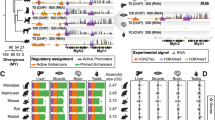Abstract.
Hybrid sequences have been described previously that consist of a 5′ region homologous to ORF2 of LINEs and a 3′ end that shares homology with a sequence located in the first intron of Cε immunoglobulin. The present investigation has revealed 14 new sequences from seven murine species, that show high homology to those observed earlier. Database search has found several new homologous hybrid sequences including one located in the mouse T-cell receptor (Tcra) locus. Several interesting features of this sequence include identical 15-bp flanking short direct repeats as well as poly-A signal and A-rich sequence at the 3′ end. We have classified this set of sequences as LINE-derived elements (LDEs), which constitute a newly observed subfamily. Comparative analysis of these sequences suggests that a single recombination event was responsible for the production of an LDE progenitor. The phylogenetic tree shows a number of elements that pre-existed in the common ancestor of murine species and displays different evolutionary rates. The time of LDE origin is estimated at approximately 10–15 MYA.
Similar content being viewed by others
Author information
Authors and Affiliations
Additional information
Received: 11 February 1998 / Accepted: 4 August 1998
Rights and permissions
About this article
Cite this article
Flood, W., Rogozin, I. & Ruvinsky, A. A novel subfamily of LINE-derived elements in mice. 9, 881–885 (1998). https://doi.org/10.1007/s003359900887
Issue Date:
DOI: https://doi.org/10.1007/s003359900887




